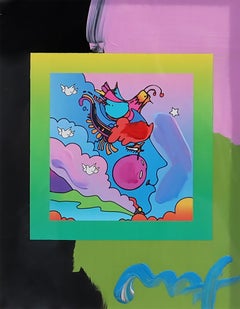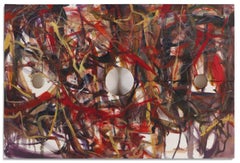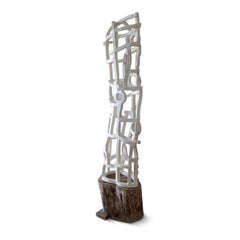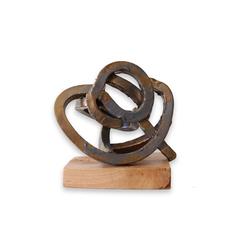Peter Max A Better World 9 X 12
21st Century and Contemporary Modern Mixed Media
Acrylic, Lithograph
Early 2000s Abstract Abstract Paintings
Oil
Recent Sales
2010s Abstract Abstract Sculptures
Stoneware, Cedar
2010s Abstract Abstract Sculptures
Ceramic, Stoneware, Birch
2010s Abstract Abstract Sculptures
Ceramic, Stoneware, Glaze
2010s Abstract Abstract Sculptures
Ceramic, Stoneware, Cedar
2010s Abstract Abstract Sculptures
Ceramic, Stoneware, Birch
2010s Abstract Abstract Sculptures
Ceramic, Stoneware, Birch
2010s Abstract Abstract Sculptures
Ceramic, Stoneware, Birch
2010s Abstract Abstract Sculptures
Ceramic, Stoneware
21st Century and Contemporary Abstract Abstract Sculptures
Ceramic, Wood
2010s Abstract Sculptures
Ceramic, Wood
2010s Abstract Abstract Sculptures
Ceramic, Stoneware, Birch
2010s Abstract Abstract Sculptures
Ceramic, Stoneware, Birch
2010s Abstract Abstract Sculptures
Ceramic, Stoneware, Birch
2010s Abstract Abstract Sculptures
Ceramic, Stoneware, Birch
2010s Abstract Sculptures
Ceramic, Wood
People Also Browsed
21st Century and Contemporary Portuguese Modern Sofas
Velvet
21st Century and Contemporary Books
Foil
Vintage 1970s English Figurative Sculptures
Sterling Silver
21st Century and Contemporary Vietnamese George II Dry Bars
Wood
Antique 19th Century French Moorish Busts
Bronze
Antique 1720s Spanish Baroque Beds and Bed Frames
Giltwood, Paint
Early 20th Century English Charles II Settees
Tapestry, Velvet
2010s American Modern Buffets
Stone, Brass
Antique Early 18th Century French Baroque Western European Rugs
Silk, Wool
1920s Art Deco Portrait Paintings
Oil
Antique Early 1900s German Rococo Dinner Plates
Porcelain
Mid-20th Century Danish Mid-Century Modern Sterling Silver
Sterling Silver
Antique 19th Century Russian Neoclassical Sculptures
Bronze
Early 20th Century Modern Figurative Paintings
Canvas, Oil
Mid-19th Century Hudson River School Landscape Paintings
Paper, Oil, Board
Antique Late 19th Century French Belle Époque Tableware
Porcelain
Brandon Reese for sale on 1stDibs
A Close Look at Abstract Art
Beginning in the early 20th century, abstract art became a leading style of modernism. Rather than portray the world in a way that represented reality, as had been the dominating style of Western art in the previous centuries, abstract paintings, prints and sculptures are marked by a shift to geometric forms, gestural shapes and experimentation with color to express ideas, subject matter and scenes.
Although abstract art flourished in the early 1900s, propelled by movements like Fauvism and Cubism, it was rooted in the 19th century. In the 1840s, J.M.W. Turner emphasized light and motion for atmospheric paintings in which concrete details were blurred, and Paul Cézanne challenged traditional expectations of perspective in the 1890s.
Some of the earliest abstract artists — Wassily Kandinsky and Hilma af Klint — expanded on these breakthroughs while using vivid colors and forms to channel spiritual concepts. Painter Piet Mondrian, a Dutch pioneer of the art movement, explored geometric abstraction partly owing to his belief in Theosophy, which is grounded in a search for higher spiritual truths and embraces philosophers of the Renaissance period and medieval mystics. Black Square, a daringly simple 1913 work by Russian artist Kazimir Malevich, was a watershed statement on creating art that was free “from the dead weight of the real world,” as he later wrote.
Surrealism in the 1920s, led by artists such as Salvador Dalí, Meret Oppenheim and others, saw painters creating abstract pieces in order to connect to the subconscious. When Abstract Expressionism emerged in New York during the mid-20th century, it similarly centered on the process of creation, in which Helen Frankenthaler’s expressive “soak-stain” technique, Jackson Pollock’s drips of paint, and Mark Rothko’s planes of color were a radical new type of abstraction.
Conceptual art, Pop art, Hard-Edge painting and many other movements offered fresh approaches to abstraction that continued into the 21st century, with major contemporary artists now exploring it, including Anish Kapoor, Mark Bradford, El Anatsui and Julie Mehretu.
Find original abstract paintings, sculptures, prints and other art on 1stDibs.
Finding the Right Abstract-sculptures for You
If you’re thinking about decorating your space with abstract sculpture, there are a couple of things to keep in mind.
You don’t have to look for a piece that demands attention. Find a work of abstract sculpture that speaks to you. As is the case with any abstract art, whether it’s sculpture, an abstract painting or a grouping of prints, you can select a work for your living room or dining room, for example, that will either casually fade into the background or serve as a focal point. When you’re thinking about how to arrange your furniture and decor, consider color, texture and what kind of energy you’d like a specific room or corner to evoke. Abstract sculpture can go a long way in elevating a home, and its history is interesting if you’re shopping for a new piece today.
As a pioneer in naturalistic forms and figures that vividly express emotion, Auguste Rodin is often called the father of modern sculpture. His work in the 19th and early 20th century broke with artistic conventions and inspired modernism, leading to a new period of avant-garde abstraction.
Among the first artists to push abstract sculpture into the mainstream were Pablo Picasso and Georges Braque. They helped define the movement of Cubism, which focused on deconstructing the world abstractly.
Later in the 20th century, the artistic movements of Italian Futurism, Dadaism, Neo-Dadaism, Surrealism, Abstract Expressionism and minimalism all contributed to the advancement of new and more abstract sculpture designs. Italian Futurism, for example, celebrated movement, dynamics and technology in abstract sculpture. These movements passed down ideas that continue to inform abstract sculpture today.
Browse a range of modern abstract sculptures, postmodern abstract sculptures and other kinds of sculpture on 1stDibs.



